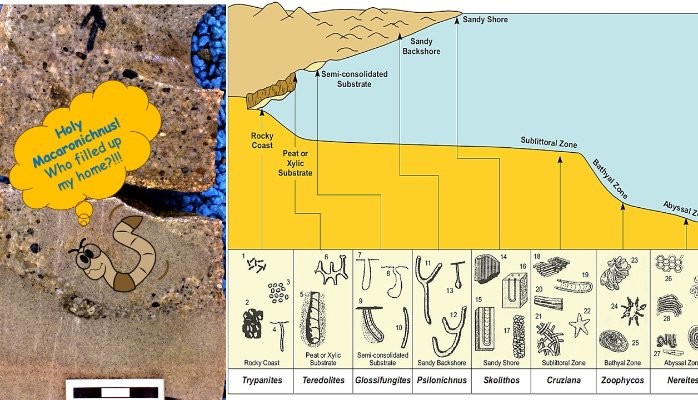
The Role of Ichnology in Sequence Stratigraphic Analysis: A Brief Overview
Imagine how many times in the past 'we' shied away from whole boxes of cores, just because they have been 'chewed up' or 'churned' or 'pooched' by some 'bug' totally disrespectful of primary sedimentary structures! But thanks to numerous studies pioneered by Adolf Seilacher and championed by George Pemberton, James MacEachern, Bromley and others, ichnology (a more pedantic way of saying 'trace-fossil study') is now well established as a powerful tool in stratigraphic and sedimentological analyses of such pooched rocks.
George Pemberton and James MacEachern (1992) pointed out that the utility of ichnology in sequence stratigraphy is twofold: 1) recognition of key surfaces using substrate controlled trace fossils, and 2) recognition of depositional environments by careful analysis of vertical ichnological successions. Moreover, in cases where the primary sedimentary structures are obliterated, they provide the only evidence for assessing the depositional environment.
Bromley et al. (1984) established three substrate controlled ichnofacies, namely, Trypanites (hardground suits), Teredolites (woodground suits), and Glossifungites (firmground suits). In the Cretaceous Western Interior Seaway, Glossifungites is the only recognized ichnofacies used for determining regional stratigraphic discontinuities (Pemberton and MacEachern, 1992).
In marine sliciclastic environments, a firmground generally refers to a firm but unlithified substrate that had undergone compaction and dewatering during burial (suppose you poke a hole on a sandy beach with your finger. Now pull your finger out. If the hole is still there, the sand is a firmground. If the hole disappears, it's rather a 'softground').
Exhumation of such strata by erosion allows the Glossifungites ichnofacies to develop ((Fig. -1 & 2).
The erosional surface may be generated by subaerial exposure. But the colonization of the Glossifungites ichnogenera essentially occurs in a marine or marginal marine condition (Pemberton et al., 2001). Thus the presence of a firmground suite indicates depositional hiatus between the erosional event and the overlying strata and such erosional discontinuities corresponds to sequence stratigraphic surfaces, such as the sequence boundary/regressive surface of erosion (RSE), and the transgressive surface of erosion (TSE).
My own initiation into ichnology was through none other than James MacEachern, one of the Archangels of Ichnology ( of course if you consider Pemberton as God), who was spending a part of his sabbatical at UTD Dallas while I was in the middle of my PhD. under Professor Janok Bhattacharya. At that point in time, I was trying to trying to decipher parsequence boundaries in some rocks of the Frontier Formation in the Powder River Basin. It was a challenging task because the rocks in my cores appeared amalgamated, while their counterparts in the outcrop showed clearly defined parasequence boundaries demarcated by marine mud on top of coarsening up units. But with James joining our research team, we were able to conduct a detailed ichnological study of the rocks and develop reasonable criteria for distinguishing the cryptic Flooding Surfaces of the parasequences. We identified clues of 'deepening' by observing an increasing Bioturbation Intensity (BI),as well as transition from restricted, deltaic suits to more open-marine suits of ichnogenera at the top of each unit (Fig. -3).
Also there was an abundance of 'Palimpsest Softgounds' suits as evidence for minor hiatus between the individual parasequences. Palimpsest, as you know refers to the ancient practice of over-writing on parchment, in order to minimize waste of 'paper'; palimpsest softground in our case, means burrowed softground that is passively infilled by later sedimentation, just like in case of a 'glossi surface'. But in this case, there was not enough time for lithification before the burrowing. Therefore, you are still able to see some of the remnant mud-lining of the borrow used by the organism to protect its house from collapsing (Fig.-4).
This resolved my problem of identifying parasequence boundaries in amalgamated successions and also helped me publish a paper on the topic.
Later on in my professional career, I have been able to utilize ichnology as an indispensable tool in developing sequence stratigraphic frameworks, not only in the Western Interior Seaway, but also in much of my work on the West African Shelf (Fig.-5).
Fundamental concepts established from trace fossil assemblages of the Cretaceous Interior Seaway appears to equally applicable to all these other basins. Therefore, this well-documented ichnological model of the Western Interior Seaway (Fig.-6) needs to be visited again and again, no matter in which part of the world you are working.
We (Applied Stratigraphix LLC.) recently ran a two-day public workshop (August 30-31) in Denver in collaboration with PTTC in order to just do that! There, we pulled out a lot my favorite Frontier Formation cores from the Powder River Basin, as well as Muddy (J) Sandstones from the Denver Basin for the Workshop. Keep an eye, we will run it again!
Figure-6 : After Pemberton et al., 2001
Ok, I guess now it is time for me to create a Fugichnia (Fig.-7) and bug out of here already!
Figure-7







Retired. TEFL, Consulting Geologist, Biostrat micropaleontology. Ops Geology workflows. Explorationist team player.
7yNice article on an interesting topic. Trace fossil analysis has progressed by leaps and bounds over the last 40 years - the span of my working career.
Senior Project Geologist chez Indépendant/Gondwanaland Services
7yOnce retired, a strong hope is to organize the first international workshop on the integration of ichnology and sedimentology for a better sequence stratigraphy interpretation of the Paleozoic rocks deposition across the south eastern part of the Algerian Sahara (Tassili N'Ajjer). A great economic impact regarding the Oil & Gas industry in the country and overall North Africa (northern Gondwana). An incredibly well preserved natural museum which knowledge has to be shared with the worldwide scientific community.
Nurse station clerk
7yInteresting article. I am not a fossil kind of guy. I had wished the names of fossils were not some long Greek or Latin nomenclature but the author of this article had very colorful stratigraphic columns and charts detailing his research. I understood clearly the transgressive(coarsening upwards sequence)/regressive(fining upwards sequence) sedimentation cycles. Nice job!